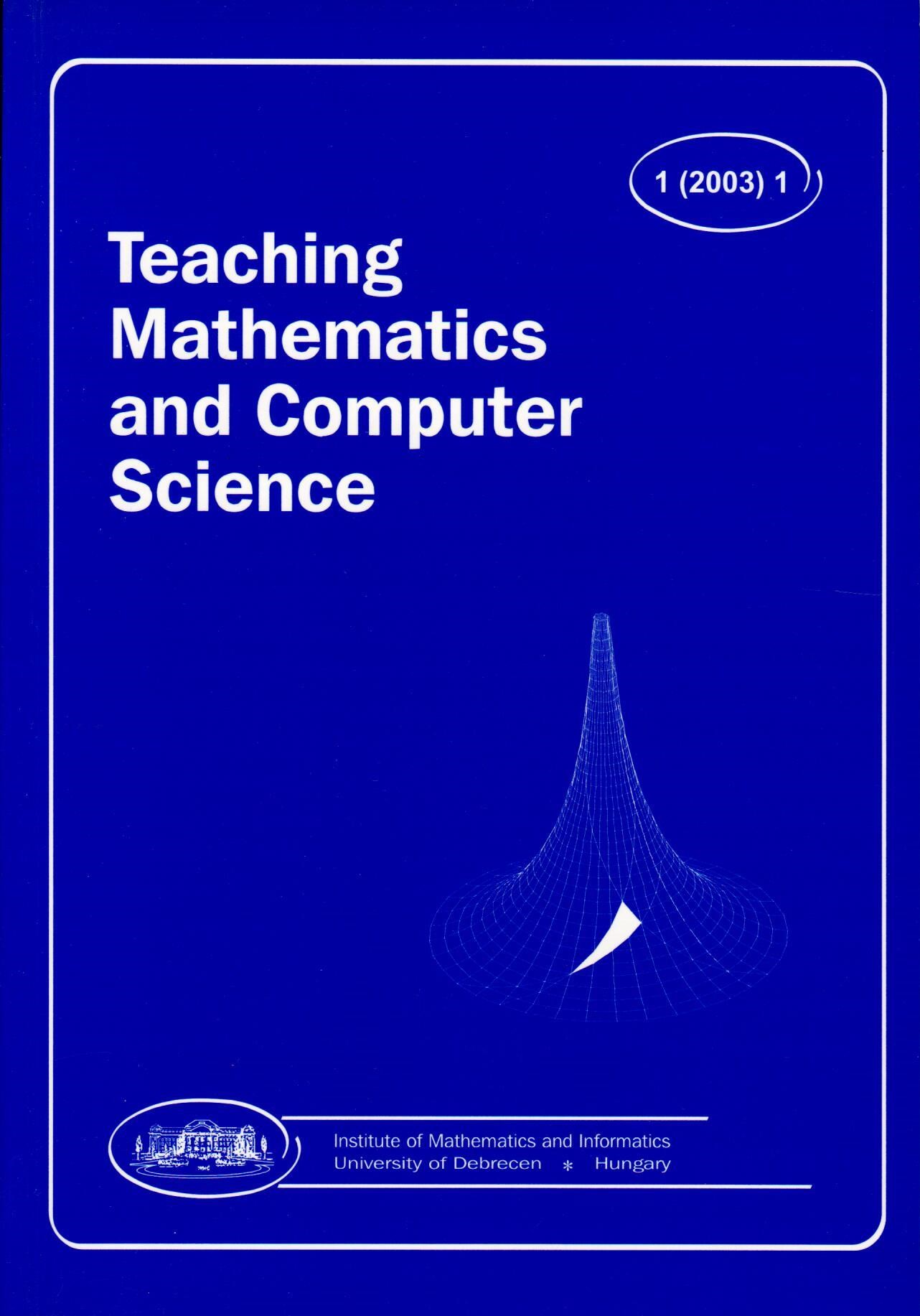Vol. 1 No. 1 (2003)
Published
2003 June 1
##issue.tableOfContents##
Articles
-
The unity of mathematics: a casebook comprising practical geometry number theory and linear algebra
1-34Views:83We give a sustained example, drawn largely from earlier publications, of how we may freely pursue a line of mathematical enquiry if we are not constrained, unnaturally, to confine ourselves to a single mathematical subdiscipline; and we draw conclusions from the study of this example which are relevant at many levels of mathematical instruction.
We also include the statement and proof of a new result (Theorem 4.1) in linear algebra which is obviously fundamental to the geometrical investigation which constitutes the leit-motif of the paper.PDF83 -
Gaussian iteration of mean values and the existence of 2^(1/2)
35-42Views:91We propose a method for proving the existence of √2 and finding its approximate value in secondary education.PDF58 -
Why is the gamma function so as it is?
43-53Views:106This is a historical note on the gamma function Γ. The question is, why is Γ(n) for naturals n equal to (n−1)! and not equal to n! (the factorial function n! = 1·2 · · · n) ? Was A. M. Legendre responsible for this transformation, or was it L. Euler? And, who was the first who gave a representation of the so called Euler gamma function?PDF146 -
Teaching student teachers: various components of a complex task
55-72Views:78In this paper we summarize various aspects of teacher training and teaching student teachers (mainly concerning teachers of upper secondary school and High school). We stress several hints and recommendations to better achieve the obviously important aim: they should learn doing, understanding and teaching mathematics!
Of course, our view is particularly influenced by European traditions, but we think most of them equally apply to teacher training and teaching student teachers elsewhere. Neither is the paper meant to give an all sided overview about the problem field of teacher education as a whole, nor does it contain provocative, completely new ideas. We just want to describe our view of some aspects, based primarily on our personal experience in the mentioned field.PDF56 -
Mathematical gems of Debrecen old mathematical textbooks from the 16-18th centuries
73-110Views:82In the Great Library of the Debrecen Reformed College (Hungary) we find a lot of old mathematical textbooks. We present: Arithmetic of Debrecen (1577), Maróthi's Arithmetic (1743), Hatvani's introductio (1757), Karacs's Figurae Geometricae (1788), Segner's Anfangsgründe (1764) and Mayer's Mathematischer Atlas (1745). These old mathematical textbooks let us know facts about real life of the 16-18th centuries, the contemporary level of sciences, learning and teaching methods. They are rich sources of motivation in the teaching of mathematics.PDF35 -
Hyperbolische 5-Rechtecke
111-123Views:92The main topic of this paper is the investigation of 5-pentagons whose interior angles are all right angles within the hyperbolic geometry (so-called 5-rectangles). Some knowledge of elementary hyperbolic geometry is required.
At first the existence of such a polygon is shown by construction within the Kleinmodel. Then two formulas due to D. M. Y. Sommerville [3] are proved. This means to juggle with trigonometric formulas of hyperbolic geometry.
In the last years a big number of papers concerning hyperbolic geometry was published. This proves that the interest in this nice discipline is growing again.PDF (German)59 -
Aspects théoriques de la classification à base de treillis
125-135Views:98La classification est une notion cruciale dans les systémes orientés objets et se fait de plus en plus présente en représentation de connaissances. Elle permet principalement de trouver des regularités dans un grand tableau de nombres. Dans ce sens général, il s'agit donc d'une méthode qui joue un role important dans différents domaines scientifiques oú les connaissances sont á organiser selon certaines hiérarchies (biologie, chimie, etc.). En informatique nous parlons aussi de langages de classes sans mentionner es aspects mathématiques de la classification. Dans cet article l'auteur a pour but de proposer une introduction á la classification á travers la notion de treillis. Nous sommes persuadés que l'étude de la classification permet aux étudiants de familiariser leurs connaissances sur la modélisation et la programmation orientée objet.
The classification is a crucial notion in the object oriented systems and more and more appears in the knowledge representation. It allows us to find the regularities in a huge table of numbers. In this general sense the classification plays an important role in various domains of science, where knowledge has to be organized into hierarchy (biology, chemistry, etc.) In the computer science the languages of classes are often studied without mathematical aspects of the classification. In this paper the author has the goal to propose an introduction to the classification through the notion of lattices.We are convinced that the study of classification allows students to enlarge their knowledge on the object oriented modelling and programming.PDF (French)64 -
A first course in computer science: languages and goals
137-152Views:78The College Board Advanced Placement exam in computer science will use the language Java starting in fall 2003. The language chosen for this exam is based on the language commonly taught in introductory computer science courses at the university level. This article reviews the purpose of an introductory course and the various suggestions for the curriculum of introductory courses published by the Association for Computing Machinery. It then proposes that such a course stress foundational concepts over specific language syntax, and then provides a list of such foundational concepts and related topics. Based on this fundamental curriculum, the article recommends C++ as the most appropriate language. An appendix provides a sample syllabus.PDF91 -
Proof without words: beyond the parallelogram law
153-156Views:73We present a visual proof of the parallelogram law and using it we can describe a visual proof of a classical theorem on convex quadrilaterals relating sides and diagonals.PDF75
Keywords
Issues by Year
2020
2017
2011
2010
2009
2007
2006
2005
2004
2003







